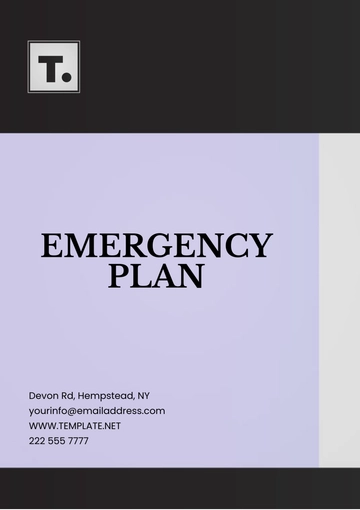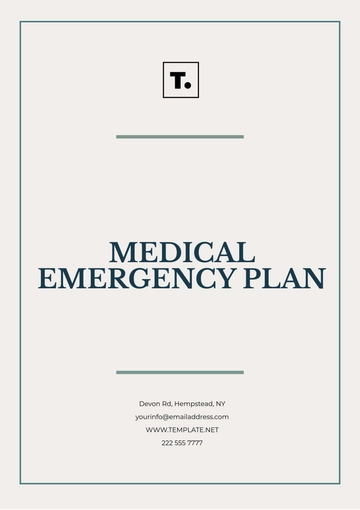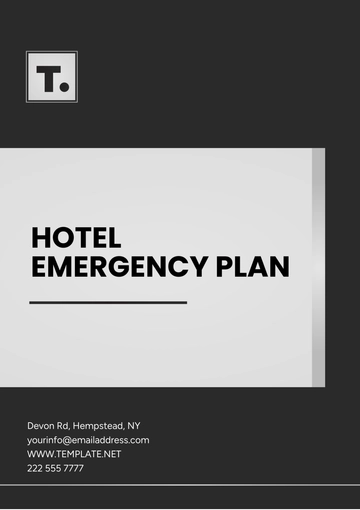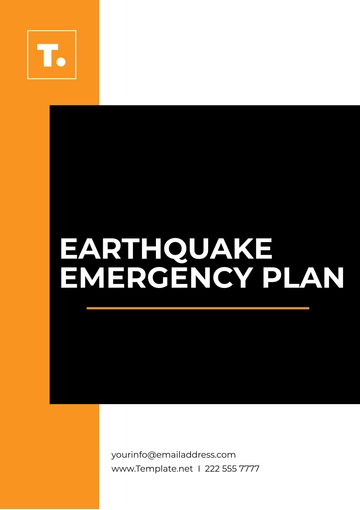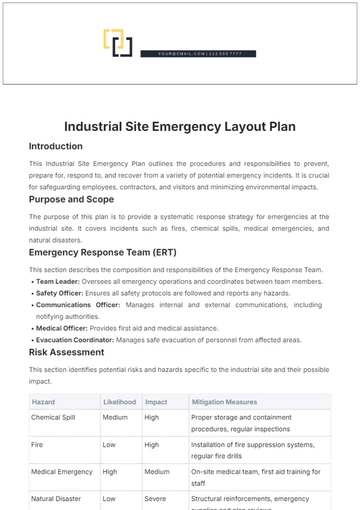Free Hospital Emergency Plan

1. Introduction
This Hospital Emergency Plan outlines the procedures and responsibilities of healthcare staff in the event of an emergency. The plan ensures the safety and well-being of patients, staff, and visitors while maintaining continuity of care. This comprehensive guide covers various emergency scenarios, including natural disasters, infectious disease outbreaks, and other critical incidents.
2. Objectives
To protect the health and safety of patients, staff, and visitors.
To ensure the continuity of critical hospital operations.
To establish clear lines of communication and decision-making during emergencies.
To provide guidelines for the efficient use of hospital resources.
To facilitate collaboration with external agencies and stakeholders.
3. Emergency Response Team (ERT)
The Emergency Response Team is responsible for implementing this emergency plan. Below is a list of key roles and responsibilities:
Position | Role |
|---|---|
Emergency Coordinator | Overall control of the emergency plan activation and operations. |
Communication Officer | Handles all communications with staff, patients, and external entities. |
Operations Manager | Oversees operational logistics, supply chain, and resource allocation. |
Safety Officer | Ensures safety protocols are implemented and adhered to by all. |
4. Risk Assessment
The hospital conducts regular risk assessments to identify potential threats and vulnerabilities. Key risks identified include:
Natural Disasters: Earthquakes, floods, hurricanes.
Fire Hazards: Electrical faults, arson.
Infectious Disease Outbreaks: Influenza, COVID-19.
Terrorism Threats: Biological, chemical attacks.
5. Emergency Procedures
Outlined below are structured procedures to be followed during emergencies:
5.1 Medical Emergencies
Activate the emergency alarm system.
Alert the Emergency Response Team.
Provide necessary medical care to patients.
Contact additional medical professionals if needed.
5.2 Fire
Immediately activate the fire alarm.
Evacuate patients and staff following the fire evacuation plan.
Use designated fire exits and routes.
Ensure safe relocation of critical medical equipment.
5.3 Infectious Disease Outbreak
Initiate isolation protocols for affected individuals.
Implement sanitation and infection control measures.
Coordinate with public health authorities.
Communicate guidelines and updates to staff and patients.
6. Communication Plan
Effective communication is crucial during emergencies. The following methods will be employed:
Intercom and PA systems for immediate alerts.
Emails and text messages for detailed instructions.
Dedicated emergency hotline for external communication.
Regular updates to the hospital’s website and social media.
7. Training and Drills
Regular training sessions and emergency drills are conducted to ensure staff readiness. Training covers:
Recognizing emergency signals and alarms.
Evacuation procedures for different emergency scenarios.
Use of emergency equipment and first aid.
Communication protocols and chain of command.
8. Resource Management
Efficient management of resources is vital in emergencies. Resource allocations include:
Resource | Description and Allocation |
|---|---|
Medical Supplies | Sufficient stocks of medical essentials and backup resources. |
Personnel | On-call specialists and shift extensions for emergencies. |
Facilities | Designated areas for triage, treatment, and isolation. |
Transportation | Access agreements with local emergency services for patient transfer. |
9. Coordination with External Agencies
The hospital ensures collaboration with local and national agencies, including:
Emergency medical services and ambulance providers.
Fire and rescue departments.
Public health departments.
State and federal emergency management agencies.
10. Review and Update
This Emergency Plan is reviewed and updated annually or as needed based on drills, actual incidents, and changes in external guidelines and best practices. Feedback is gathered from all staff to enhance the plan's effectiveness.
- 100% Customizable, free editor
- Access 1 Million+ Templates, photo’s & graphics
- Download or share as a template
- Click and replace photos, graphics, text, backgrounds
- Resize, crop, AI write & more
- Access advanced editor
The Hospital Emergency Plan Template, offered by Template.net, is the perfect solution for ensuring your healthcare facility is prepared for any crisis. This customizable, printable, and downloadable template provides a structured framework to organize emergency procedures efficiently. Easily editable in our AI Editor Tool, this template allows you to tailor every detail to meet your hospital's specific needs, ensuring safety and preparedness in every situation.
You may also like
- Finance Plan
- Construction Plan
- Sales Plan
- Development Plan
- Career Plan
- Budget Plan
- HR Plan
- Education Plan
- Transition Plan
- Work Plan
- Training Plan
- Communication Plan
- Operation Plan
- Health And Safety Plan
- Strategy Plan
- Professional Development Plan
- Advertising Plan
- Risk Management Plan
- Restaurant Plan
- School Plan
- Nursing Home Patient Care Plan
- Nursing Care Plan
- Plan Event
- Startup Plan
- Social Media Plan
- Staffing Plan
- Annual Plan
- Content Plan
- Payment Plan
- Implementation Plan
- Hotel Plan
- Workout Plan
- Accounting Plan
- Campaign Plan
- Essay Plan
- 30 60 90 Day Plan
- Research Plan
- Recruitment Plan
- 90 Day Plan
- Quarterly Plan
- Emergency Plan
- 5 Year Plan
- Gym Plan
- Personal Plan
- IT and Software Plan
- Treatment Plan
- Real Estate Plan
- Law Firm Plan
- Healthcare Plan
- Improvement Plan
- Media Plan
- 5 Year Business Plan
- Learning Plan
- Marketing Campaign Plan
- Travel Agency Plan
- Cleaning Services Plan
- Interior Design Plan
- Performance Plan
- PR Plan
- Birth Plan
- Life Plan
- SEO Plan
- Disaster Recovery Plan
- Continuity Plan
- Launch Plan
- Legal Plan
- Behavior Plan
- Performance Improvement Plan
- Salon Plan
- Security Plan
- Security Management Plan
- Employee Development Plan
- Quality Plan
- Service Improvement Plan
- Growth Plan
- Incident Response Plan
- Basketball Plan
- Emergency Action Plan
- Product Launch Plan
- Spa Plan
- Employee Training Plan
- Data Analysis Plan
- Employee Action Plan
- Territory Plan
- Audit Plan
- Classroom Plan
- Activity Plan
- Parenting Plan
- Care Plan
- Project Execution Plan
- Exercise Plan
- Internship Plan
- Software Development Plan
- Continuous Improvement Plan
- Leave Plan
- 90 Day Sales Plan
- Advertising Agency Plan
- Employee Transition Plan
- Smart Action Plan
- Workplace Safety Plan
- Behavior Change Plan
- Contingency Plan
- Continuity of Operations Plan
- Health Plan
- Quality Control Plan
- Self Plan
- Sports Development Plan
- Change Management Plan
- Ecommerce Plan
- Personal Financial Plan
- Process Improvement Plan
- 30-60-90 Day Sales Plan
- Crisis Management Plan
- Engagement Plan
- Execution Plan
- Pandemic Plan
- Quality Assurance Plan
- Service Continuity Plan
- Agile Project Plan
- Fundraising Plan
- Job Transition Plan
- Asset Maintenance Plan
- Maintenance Plan
- Software Test Plan
- Staff Training and Development Plan
- 3 Year Plan
- Brand Activation Plan
- Release Plan
- Resource Plan
- Risk Mitigation Plan
- Teacher Plan
- 30 60 90 Day Plan for New Manager
- Food Safety Plan
- Food Truck Plan
- Hiring Plan
- Quality Management Plan
- Wellness Plan
- Behavior Intervention Plan
- Bonus Plan
- Investment Plan
- Maternity Leave Plan
- Pandemic Response Plan
- Succession Planning
- Coaching Plan
- Configuration Management Plan
- Remote Work Plan
- Self Care Plan
- Teaching Plan
- 100-Day Plan
- HACCP Plan
- Student Plan
- Sustainability Plan
- 30 60 90 Day Plan for Interview
- Access Plan
- Site Specific Safety Plan
